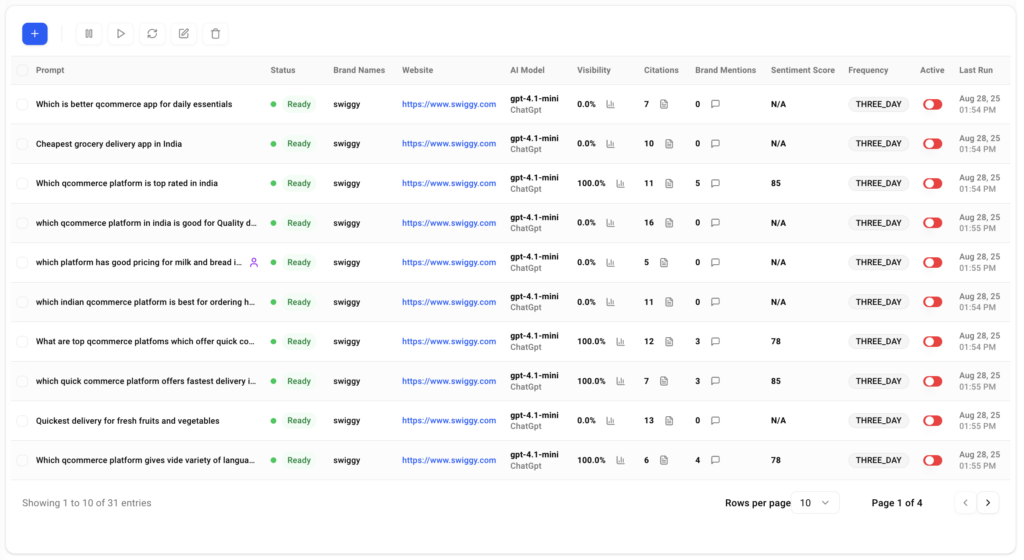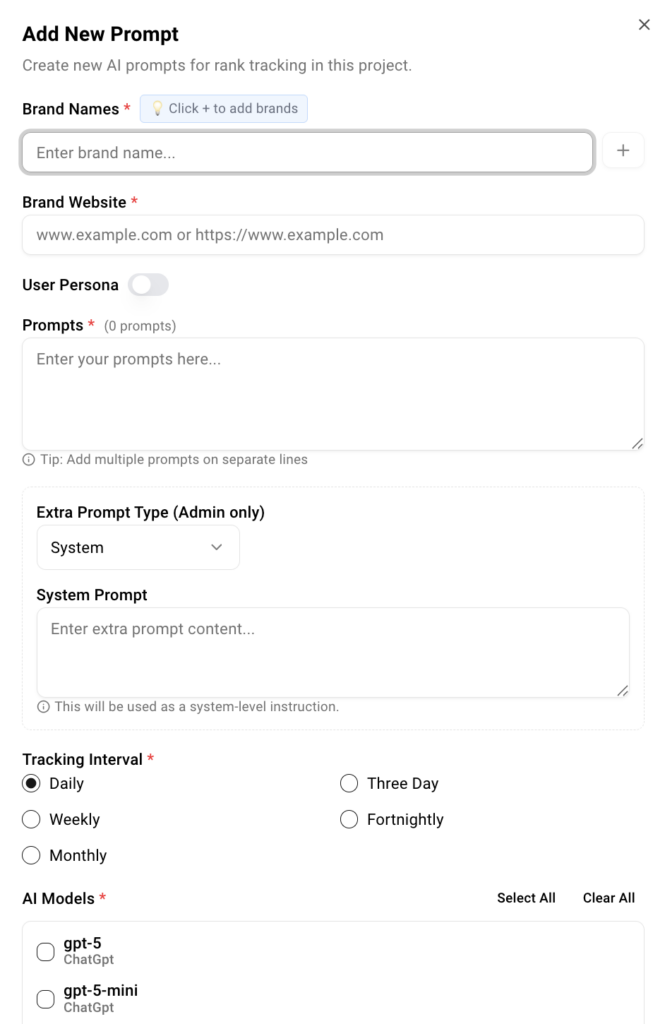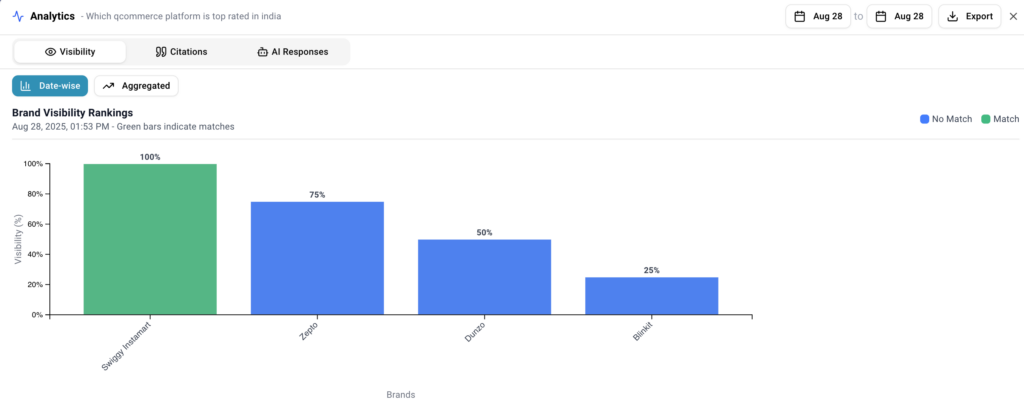The world of search is changing rapidly. Traditional SEO (Search Engine Optimization) was once the gold standard for building online visibility. But with the rise of AI-powered platforms and large language models (LLMs) like ChatGPT, Gemini, Claude, and Perplexity, businesses must adapt to a new reality: visibility is no longer only about ranking on Google.
This is where Generative Engine Optimization (GEO) comes in. Instead of optimizing just for search engines, GEO ensures your brand is visible inside AI-generated answers that users increasingly rely on.
And to track this new layer of visibility, you need the right tools. That’s where SerpFactor steps in the first dedicated generative engine optimization tool that helps you monitor, measure, and improve your brand presence across multiple LLMs.
What is Generative Engine Optimization (GEO)?
At its core, Generative Engine Optimization (GEO) is the process of optimizing your content, prompts, and brand presence so that AI-driven engines and LLMs mention your brand in their generated responses.
Unlike traditional SEO, which focuses on:
- Keywords → matching search intent for Google rankings
- Backlinks → building authority
- Technical SEO → site speed, schema, etc.
GEO (Generative Engine Optimization) focuses on:
- LLM Prompts → ensuring AI tools include your brand in responses
- Personas & Context → testing how different user personas trigger your brand visibility
- Brand Mentions → tracking frequency of appearance across LLMs
In short: SEO makes you visible in search results. GEO makes you visible in AI answers.
Why Generative Engine Optimization is Important
AI-driven platforms are becoming the default way people find answers. Instead of clicking on ten blue links, users ask:
- “What are the best SEO tools in 2025?”
- “Which platforms help with brand visibility in AI search?”
- “How can I track my business on ChatGPT?”
The answers aren’t pulled from one website they’re synthesized from multiple sources. If your brand isn’t appearing in these generative responses, you’re invisible to an entire audience segment.
That’s why geo generative engine optimization is becoming critical for:
- Businesses & Startups → who want AI to recommend their products
- Agencies & SEO professionals → who must go beyond Google rankings
- CEOs & Marketing Leaders → who need visibility in emerging AI ecosystems
How to Do Generative Engine Optimization (Step-by-Step)
Implementing GEO (Generative Engine Optimization) requires a structured approach. Here’s how you can do it effectively:
1. Define Your Target Personas
Different queries produce different AI outputs. A student, marketer, or business owner might all get different answers to the same question. You need to define personas to test how your brand appears across contexts.
👉 With SerpFactor, you can add multiple personas to simulate different types of users.
2. Create Prompts for Testing
Just like keywords in SEO, prompts are the foundation of GEO. You need to test queries such as:
- “What is the best generative engine optimization tool?”
- “How to do generative engine optimization for businesses?”
- “Top generative engine optimization services in 2025.”
👉 In SerpFactor, you can add and organize prompts to see how LLMs respond.
3. Track Responses Across LLMs
Since users rely on multiple LLMs (ChatGPT, Claude, Gemini, Perplexity), you need a tool that tracks brand mentions across all of them.
👉 Here’s an example of SerpFactor dashboard tracking prompts across LLMs

4. Analyze & Optimize
If your brand isn’t appearing:
- Adjust your content strategy.
- Create more GEO-focused assets.
- Test with different personas and prompts until visibility improves.
Generative Engine Optimization Tools
There are many ways businesses try to track their brand in AI-driven platforms, but manual tracking isn’t scalable. That’s why you need specialized generative engine optimization tools.
Why SerpFactor is the Leading GEO Tool
- Multi-LLM Tracking → Monitor visibility across ChatGPT, Claude, Gemini, Perplexity, and more.
- Persona-Based Prompts → See how your brand appears to different audience types.
- Dashboard Insights → Visualize how often your brand is mentioned in generative responses.
- Competitor Tracking → Understand how your competitors perform in GEO.
👉 Here’s how you add a new prompt for tracking on SerpFactor

Instead of guessing, SerpFactor gives you data-driven insights into how LLMs see your brand.
Benefits of Using Generative Engine Optimization Services
Brands that adopt GEO early will gain a competitive edge. Some benefits include:
- Improved AI Visibility → Your brand appears in generative responses more often.
- Data-Driven Decisions → No guessing which prompts work, SerpFactor shows real results.
- Persona-Level Insights → Understand how different customer segments perceive your brand.
- Competitive Advantage → Stay ahead of businesses that still rely solely on Google rankings.
How SerpFactor Helps You Win at GEO
Unlike traditional SEO tools, SerpFactor was built specifically for generative engine optimization (GEO).
Here’s what you can do with it:
- Track prompts across all major LLMs
- Assign personas to test AI answers
- Measure visibility trends over time
- Generate reports to share with your team or clients
👉 Here’s an example of visibility trends in SerpFactor

Whether you’re a marketer, SEO professional, or business leader, SerpFactor makes it simple to optimize for the new world of generative search.
Conclusion
The future of search is generative, not just algorithmic. Brands that invest in Generative Engine Optimization (GEO) today will dominate tomorrow’s AI-driven landscape.
By understanding what is generative engine optimization, learning how to do generative engine optimization, and using the right generative engine optimization tools, you ensure your business isn’t left behind.
And with SerpFactor, you can track, test, and optimize your GEO strategy across all major LLMs from prompts to personas.
🚀 Start optimizing your AI visibility today.
👉 Sign up for SerpFactor
📩 Contact us at business@serpfactor.com